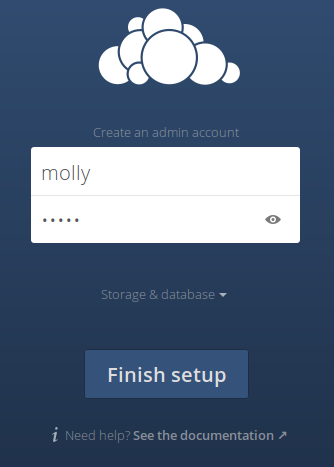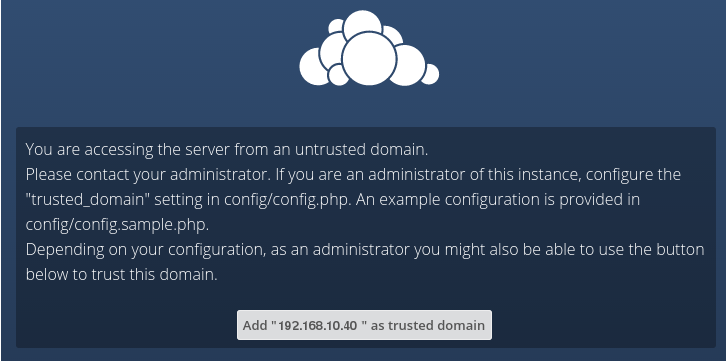Installation Wizard¶
Quick Start¶
When ownCloud prerequisites are fulfilled and all ownCloud files are installed, the last step to completing the installation is running the Installation Wizard. This is just three steps:
- Point your Web browser to http://localhost/owncloud
- Enter your desired administrator’s username and password.
- Click Finish Setup.
You’re finished and can start using your new ownCloud server.
Of course, there is much more that you can do to set up your ownCloud server for best performance and security. In the following sections we will cover important installation and post-installation steps. Note that you must follow the instructions in Setting Strong Permissions in order to use the occ Command.
Data Directory Location¶
Click Storage and Database to expose additional installation configuration options for your ownCloud data directory and database.
You should locate your ownCloud data directory outside of your Web root if you are using an HTTP server other than Apache, or you may wish to store your ownCloud data in a different location for other reasons (e.g. on a storage server). It is best to configure your data directory location at installation, as it is difficult to move after installation. You may put it anywhere; in this example is it located in /var/oc_data. This directory must already exist, and must be owned by your HTTP user (see Setting Strong Directory Permissions).
Database Choice¶
SQLite is the default database for ownCloud Server (it is not available and not supported in the Enterprise edition), and it is good only for testing and lightweight single-user setups without client synchronization. Supported databases are MySQL, MariaDB, Oracle 11g, and PostgreSQL, and we recommend MySQL/MariaDB. Your database and PHP connectors must be installed before you run the Installation Wizard. When you install ownCloud from packages all the necessary dependencies will be satisfied (see Manual Installation on Linux for a detailed listing of required and optional PHP modules). You will need the root database login, or any administrator login that has permissions to create and modify databases, and then enter any name you want for your ownCloud database.
Click Finish Setup, and start using your new ownCloud server.
Now we will look at some important post-installation steps.
Trusted Domains¶
All URLs used to access your ownCloud server must be whitelisted in your config.php file, under the trusted_domains setting. Users are allowed to log into ownCloud only when they point their browsers to a URL that is listed in the trusted_domains setting. You may use IP addresses and domain names. A typical configuration looks like this:
'trusted_domains' =>
array (
0 => 'localhost',
1 => 'server1.example.com',
2 => '192.168.1.50',
),
The loopback address, 127.0.0.1, is automatically whitelisted, so as long as you have access to the physical server you can always log in. In the event that a load balancer is in place there will be no issues as long as it sends the correct X-Forwarded-Host header. When a user tries a URL that is not whitelisted the following error appears:
Setting Strong Directory Permissions¶
For hardened security we recommend setting the permissions on your ownCloud directories as strictly as possible, and for proper server operations. This should be done immediately after the initial installation. Your HTTP user must own the config/, data/ and apps/ directories so that you can configure ownCloud, create, modify and delete your data files, and install apps via the ownCloud Web interface.
You can find your HTTP user in your HTTP server configuration files. Or you can use PHP Version and Information (Look for the User/Group line).
- The HTTP user and group in Debian/Ubuntu is www-data.
- The HTTP user and group in Fedora/CentOS is apache.
- The HTTP user and group in Arch Linux is http.
- The HTTP user in openSUSE is wwwrun, and the HTTP group is www.
Note
When using an NFS mount for the data directory, do not change its ownership from the default. The simple act of mounting the drive will set proper permissions for ownCloud to write to the directory. Changing ownership as above could result in some issues if the NFS mount is lost.
The easy way to set the correct permissions is to copy and run this script. Replace the ocpath variable with the path to your ownCloud directory, and replace the htuser and htgroup variables with your HTTP user and group:
#!/bin/bash
ocpath='/var/www/owncloud'
htuser='www-data'
htgroup='www-data'
rootuser='root' # On QNAP this is admin
find ${ocpath}/ -type f -print0 | xargs -0 chmod 0640
find ${ocpath}/ -type d -print0 | xargs -0 chmod 0750
chown -R ${rootuser}:${htgroup} ${ocpath}/
chown -R ${htuser}:${htgroup} ${ocpath}/apps/
chown -R ${htuser}:${htgroup} ${ocpath}/config/
chown -R ${htuser}:${htgroup} ${ocpath}/data/
chown -R ${htuser}:${htgroup} ${ocpath}/themes/
chown ${rootuser}:${htgroup} ${ocpath}/.htaccess
chown ${rootuser}:${htgroup} ${ocpath}/data/.htaccess
chmod 0644 ${ocpath}/.htaccess
chmod 0644 ${ocpath}/data/.htaccess
If you have customized your ownCloud installation and your filepaths are different than the standard installation, then modify this script accordingly.
This lists the recommended modes and ownership for your ownCloud directories and files:
- All files should be read-write for the file owner, read-only for the group owner, and zero for the world
- All directories should be executable (because directories always need the executable bit set), read-write for the directory owner, and read-only for the group owner
- The apps/ directory should be owned by [HTTP user]:[HTTP group]
- The config/ directory should be owned by [HTTP user]:[HTTP group]
- The themes/ directory should be owned by [HTTP user]:[HTTP group]
- The data/ directory should be owned by [HTTP user]:[HTTP group]
- The [ocpath]/.htaccess file should be owned by root:[HTTP group]
- The data/.htaccess file should be owned by root:[HTTP group]
- Both .htaccess files are read-write file owner, read-only group and world



